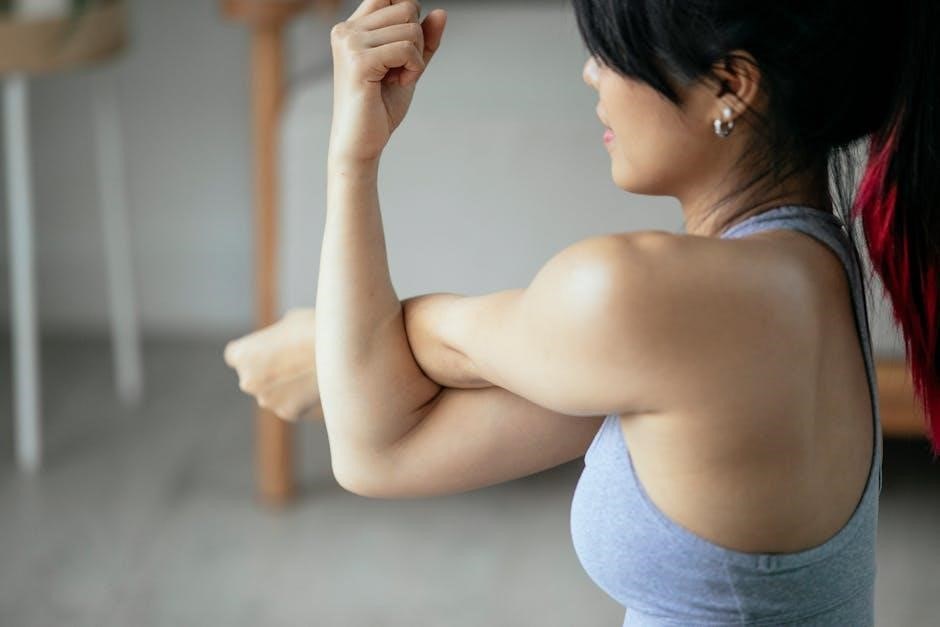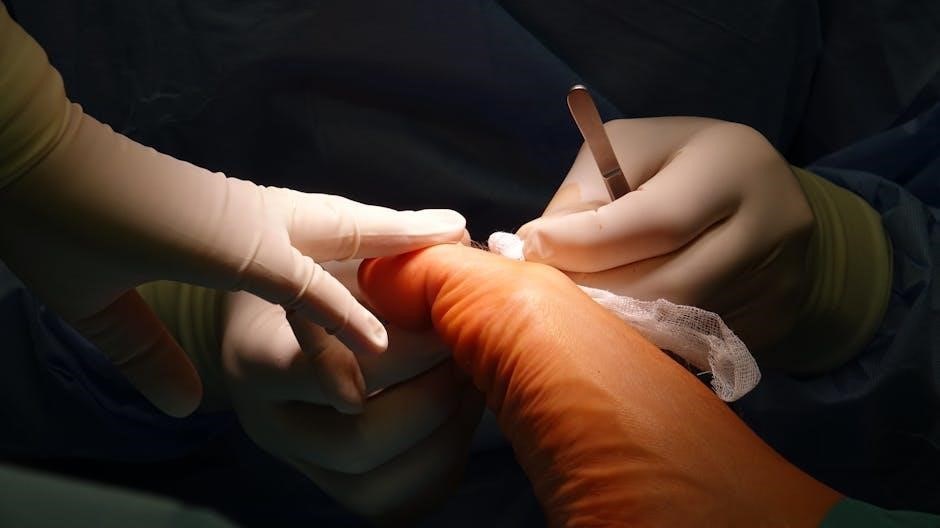Shoulder and arm workouts are essential for building upper-body strength and improving posture. These exercises cater to all fitness levels‚ requiring minimal equipment. They enhance muscle tone‚ reduce injury risk‚ and boost overall athleticism‚ making them a cornerstone of any fitness routine.
1.1 Benefits of Stronger Arms and Shoulders
Stronger arms and shoulders enhance overall upper-body strength‚ improving posture and reducing injury risk. They boost athletic performance and daily activities like lifting or carrying objects. Toned muscles contribute to a more defined physique‚ while increased strength improves endurance and confidence. Strengthening these areas also supports long-term joint health and stability‚ making everyday tasks easier. Additionally‚ well-developed arms and shoulders can enhance aesthetics‚ creating a balanced and proportionate appearance. Overall‚ building strength in these areas is a foundation for both functional fitness and personal goals‚ offering numerous benefits for health and performance.
1.2 Importance of Targeting Biceps‚ Triceps‚ and Shoulder Muscles
Targeting biceps‚ triceps‚ and shoulder muscles is crucial for achieving a balanced upper-body workout. These muscle groups are essential for functional strength‚ enabling movements like lifting‚ pushing‚ and pulling. Strengthening the biceps and triceps improves arm definition and overall muscle growth‚ while focusing on the shoulders enhances stability and posture. Neglecting these areas can lead to muscle imbalances and increased injury risk. A well-rounded routine ensures proportional development‚ boosting both aesthetics and performance. By incorporating exercises that target these muscles‚ individuals can achieve a stronger‚ more toned upper body that supports daily activities and athletic endeavors‚ promoting overall fitness and health effectively.

Understanding the Muscle Groups
Shoulder and arm workouts involve targeting key muscle groups like deltoids‚ biceps‚ and triceps. Understanding their anatomy and functions is essential for designing effective workout routines.
2.1 Anatomy of the Shoulder Muscles (Deltoids)
The deltoids are the primary muscles of the shoulder‚ divided into three heads: anterior‚ lateral‚ and posterior. These muscles control flexion‚ abduction‚ and extension of the shoulder joint. The anterior deltoids assist in forward movements‚ while the lateral deltoids contribute to side raises. The posterior deltoids help in pulling movements and stabilize the shoulder during exercises like lateral raises. Understanding the deltoids’ anatomy is crucial for targeting them effectively in workouts‚ ensuring balanced development and preventing muscle imbalances. Strong deltoids enhance overall shoulder function‚ improve posture‚ and support various daily and athletic activities.
2.2 Anatomy of the Arm Muscles (Biceps and Triceps)
The arm muscles primarily consist of the biceps brachii and triceps brachii. The biceps‚ located on the front of the arm‚ is a two-headed muscle responsible for elbow flexion and forearm supination. It has two tendons that attach to the shoulder‚ making it vital for movements like lifting and curling. The triceps‚ on the back of the arm‚ is a three-headed muscle that straightens the elbow‚ opposing the biceps. Its three heads converge into a single tendon‚ providing powerful extension for activities like pushing and throwing. Together‚ these muscles enable a wide range of arm movements‚ from lifting to pushing‚ and are essential for both athletic performance and daily tasks.

Warm-Up Routines for Shoulder and Arm Workouts
Arm circles and dynamic stretching are excellent warm-ups for shoulders and arms‚ improving mobility and reducing injury risk. These exercises prepare muscles for effective workouts.
3.1 Arm Circles as a Perfect Warm-Up Exercise
Arm circles are an excellent warm-up for shoulder workouts. Stand with feet shoulder-width apart‚ extend arms‚ and make small circles forward for 30 seconds. Switch direction for another 30 seconds. This movement enhances shoulder mobility‚ activates muscles‚ and improves blood flow. It’s simple‚ requiring no equipment‚ and suitable for all fitness levels. Arm circles prepare the shoulders for more intense exercises‚ reducing injury risk. Incorporate this exercise into your routine to ensure a safe and effective workout session.
3.2 Dynamic Stretching for Shoulder Mobility
Dynamic stretching is a vital component of shoulder and arm workouts‚ enhancing mobility and flexibility. It involves active movements that mimic workout motions‚ such as arm swings‚ cross-body stretches‚ and shoulder rolls. These exercises prepare the shoulders for intense training by increasing blood flow and reducing stiffness. Dynamic stretching improves range of motion‚ reduces injury risk‚ and ensures optimal performance during workouts. Unlike static stretches‚ dynamic movements keep the muscles engaged‚ making them ideal for pre-workout routines. Incorporate arm circles‚ lateral raises‚ and forward folds to create a comprehensive dynamic stretching routine that targets the shoulder muscles effectively.

Shoulder Exercises for Strength and Toning
Shoulder exercises like overhead presses and lateral raises are effective for building strength and toning deltoids. These movements target all shoulder muscles‚ requiring minimal equipment for a full workout.
4.1 Overhead Press for Deltoid Development
The overhead press is a highly effective compound exercise for developing the deltoid muscles. It targets the anterior‚ medial‚ and posterior deltoids‚ promoting balanced shoulder growth. To perform‚ stand tall with feet shoulder-width apart‚ grip the bar or dumbbells slightly wider than shoulder-width‚ and press upwards until arms are fully extended. Lower the weight back to shoulder height with control. Proper form is crucial to avoid injury and maximize results. Using dumbbells allows for greater range of motion‚ while a barbell enables heavier loads. Incorporate this exercise for strong‚ defined shoulders and improved upper-body strength.
4.2 Lateral Raises for Shoulder Width
Lateral raises are an excellent isolation exercise for targeting the medial deltoids‚ enhancing shoulder width and overall aesthetics; Stand with feet shoulder-width apart‚ hold dumbbells or a cable handle at your sides‚ and lift the weight outwards until your arms are at shoulder height. Maintain a slight bend in the elbows and avoid swinging. Focus on controlled movement‚ squeezing the deltoids at the top. This exercise is versatile‚ allowing the use of dumbbells‚ cables‚ or machines. Proper form is essential to prevent injury and ensure effective muscle engagement. Incorporate lateral raises to achieve broader‚ more defined shoulders‚ improving both posture and upper-body symmetry.
4.3 Front Raises for Anterior Deltoids
Front raises are a powerful exercise targeting the anterior deltoids‚ crucial for building strength and definition in the front of the shoulders. Stand tall with feet shoulder-width apart‚ holding dumbbells or a cable handle in front of your thighs. With a slight bend in the elbows‚ lift the weight forward until your arms are parallel to the ground. Avoid swinging and maintain control throughout the movement. This exercise enhances shoulder stability‚ improves posture‚ and contributes to a more balanced upper-body physique. Incorporate front raises into your routine to strengthen and sculpt the anterior deltoids effectively.
4.4 Bent-Over Lateral Raises for Rear Deltoids
Bent-over lateral raises are an effective exercise for targeting the rear deltoids‚ enhancing shoulder strength and posture. Stand with feet shoulder-width apart‚ bend at the hips‚ and hold dumbbells with arms extended. Keeping elbows slightly bent‚ lift the weights outward to shoulder height‚ squeezing the rear delts. Avoid using momentum and focus on controlled movements. This exercise improves shoulder stability‚ reduces injury risk‚ and balances overall shoulder development. Incorporating bent-over lateral raises into your routine helps build a stronger‚ more defined upper back and rear shoulders‚ complementing other shoulder exercises for a well-rounded physique.

Arm Exercises for Muscle Growth
Arm exercises enhance muscle definition‚ improve upper-body strength‚ and contribute to a balanced physique‚ targeting biceps‚ triceps‚ and forearms for functional strength and aesthetics.
5.1 Bicep Curls for Muscle Definition
Bicep curls are a staple exercise for targeting the biceps‚ enhancing muscle definition and strength. They can be performed with dumbbells‚ a barbell‚ or resistance bands. To execute properly‚ stand with feet shoulder-width apart‚ grip the weight with palms facing forward‚ and curl the weight toward your shoulders without swinging. Focus on controlled movements to maximize muscle engagement. Variations‚ such as hammer curls‚ target the brachialis and forearm muscles for a more balanced development. Incorporating bicep curls into your routine helps improve arm aesthetics and functional strength‚ making them essential for a well-rounded arm workout. Consistency and proper form are key to achieving optimal results.
5.2 Tricep Dips for Tricep Development
Tricep dips are an effective exercise for targeting the triceps‚ enhancing strength and muscle development. They can be performed using a bench‚ chair‚ or parallel bars. To execute‚ place your hands on the edge‚ extend your legs‚ and lower your body by bending your elbows until your upper arms are parallel to the ground. Push back up to the starting position‚ squeezing your triceps at the top. Tricep dips improve upper-body strength and are versatile‚ requiring minimal equipment. Proper form is essential to avoid shoulder strain. Incorporating variations‚ such as weighted dips‚ can increase intensity for advanced trainees‚ ensuring comprehensive tricep development and overall arm definition.
5.3 Hammer Curls for Forearm and Bicep Growth
Hammer curls are a versatile exercise targeting the biceps and forearms‚ promoting balanced muscle development. They involve holding dumbbells with a neutral grip‚ palms facing each other‚ and curling the weight toward your shoulders while keeping elbows close to your body. This variation reduces strain on the wrists and engages the brachialis‚ enhancing forearm strength. Hammer curls are effective for improving grip strength and creating a more symmetrical arm appearance. They can be performed standing or seated‚ making them adaptable to different workout routines. Incorporating hammer curls into your arm workout routine ensures comprehensive development of both biceps and forearms‚ complementing other exercises for a well-rounded upper body.
5.4 Overhead Tricep Extensions for Arm Strength
Overhead tricep extensions are a powerful exercise for targeting the triceps‚ enhancing arm strength and definition. Using a dumbbell‚ barbell‚ or resistance band‚ hold the weight overhead with arms extended. Lower the weight behind your head by bending your elbows‚ then push it back up to the starting position. This movement effectively isolates the triceps‚ promoting muscle growth and improved arm functionality. It’s ideal for sculpting the posterior arms and can be adapted to different fitness levels by adjusting the weight or resistance. Regular inclusion of overhead tricep extensions in your workout routine ensures strong‚ toned arms and enhanced overall upper-body strength.
Full Shoulder and Arm Workout Routine
A well-rounded routine combining shoulder and arm exercises enhances upper-body strength and definition. It targets deltoids‚ biceps‚ and triceps‚ ensuring balanced muscle development and improved posture.
6.1 Beginner-Friendly Workout Plan
A beginner-friendly workout plan focuses on foundational exercises to build strength and confidence. Start with arm circles and dynamic stretches for shoulder mobility. Perform seated dumbbell shoulder presses‚ lateral raises‚ and bicep curls using light weights. Incorporate tricep dips and overhead tricep extensions for arm development. Aim for 2-3 sets of 10-15 repetitions for each exercise. Rest for 30-60 seconds between sets and 60-90 seconds between exercises. This routine is easy to follow‚ requires minimal equipment‚ and gradually increases intensity. Focus on proper form to prevent injuries and ensure progress. Consistency and patience are key to achieving results in shoulder and arm workouts.
6.2 Intermediate Workout Plan
An intermediate workout plan increases intensity and variety to challenge muscles further. Start with overhead presses using moderate weights‚ followed by lateral raises and front raises to target shoulder width. Incorporate bicep curls with dumbbells or resistance bands for muscle definition. Tricep dips and overhead tricep extensions will enhance arm strength. Add bent-over lateral raises for rear deltoids and hammer curls for forearm growth. Aim for 3-4 sets of 12-18 repetitions per exercise. Include compound movements like push-ups or bench presses to engage multiple muscle groups. Rest for 45-60 seconds between sets and 90 seconds between exercises. This plan balances intensity and recovery for sustained progress.
6.3 Advanced Workout Plan
An advanced workout plan pushes your shoulders and arms to their limits‚ focusing on intensity and muscle fiber exhaustion. Begin with heavy overhead presses‚ clean and press‚ or weighted dips for a compound lift. Follow with high-weight lateral raises‚ front raises‚ and bent-over lateral raises to maximize shoulder development. For arms‚ perform weighted bicep curls‚ hammer curls with heavy weights‚ and tricep pushdowns using resistance bands or cables. Incorporate drop sets and supersets to enhance muscle endurance. Aim for 4-5 sets of 8-12 repetitions per exercise. Add 30-60 seconds of rest between sets and 60-90 seconds between exercises. This plan is designed for those seeking significant muscle growth and strength gains. Proper form is crucial to avoid injury and ensure effectiveness.

Tips for Effective Workouts
Vary exercises to target all muscle groups‚ incorporate rest days for recovery‚ and focus on proper form to maximize results and prevent injuries.
7.1 Adjusting Weights and Repetitions Based on Fitness Level
Adjusting weights and repetitions is crucial for effective workouts. Start with lighter weights and higher reps for endurance‚ then progress to heavier loads for strength. Beginners can focus on 12-15 reps with manageable weights‚ while intermediates might aim for 8-10 reps with moderate weights. Advanced lifters can prioritize lower reps (4-6) with heavier weights for maximum muscle growth. Gradually increase weight or reps as fitness improves to avoid plateaus. Balancing intensity with recovery ensures sustainable progress and prevents overtraining. Tailoring workouts to individual fitness levels maximizes results and keeps exercises challenging yet achievable.
7.2 Focus on Proper Form to Avoid Injury
Proper form is essential to prevent injuries and ensure effective workouts. Poor form can lead to muscle strain or long-term damage‚ especially in shoulders and arms. Always engage core muscles to maintain stability and control during exercises. Avoid swinging weights or using momentum‚ as this can strain joints and reduce the exercise’s effectiveness. Keep movements controlled and deliberate‚ focusing on the target muscle groups. For complex exercises like overhead presses or lateral raises‚ prioritize slow‚ precise motions. If unsure about form‚ consider working with a trainer or using mirrors to monitor technique. Consistent proper form fosters safer‚ more productive workouts and promotes long-term progress.
7.3 Incorporating Rest Days for Muscle Recovery
Incorporating rest days is crucial for muscle recovery and growth. Muscles repair and strengthen during rest‚ not just during workouts. Overtraining can lead to fatigue‚ decreased performance‚ and increased injury risk. Schedule rest days between intense shoulder and arm workouts to allow your muscles to recover fully. Active recovery‚ such as light cardio or stretching‚ can be beneficial but should not strain the targeted areas. Adequate rest ensures muscles rebuild stronger and more defined. Consistency in rest periods supports long-term progress and maintains overall fitness goals. Balancing rest with exercise is key to a sustainable and effective workout routine.
Safety and Injury Prevention
Proper form and technique are vital to prevent injuries. Start with lighter weights and gradually increase intensity. Avoid overtraining‚ and listen to your body to prevent strain or damage.
8.1 Common Injuries in Shoulder and Arm Workouts
Common injuries in shoulder and arm workouts include rotator cuff strains‚ shoulder impingements‚ and bicep or tricep tendonitis. Overuse‚ poor form‚ and excessive weight can lead to these issues. Shoulder injuries often arise from improper overhead presses or lateral raises‚ while arm injuries may result from heavy lifting or repetitive curls. Pulling or sharp pains during exercises can signal potential harm. Addressing these risks through proper technique and moderate intensity is crucial to avoid long-term damage and maintain a safe‚ effective workout routine.
8.2 Proper Warm-Up and Cool-Down Techniques
A proper warm-up and cool-down are vital for preventing injuries and enhancing recovery. Begin with 5-10 minutes of light cardio‚ such as jogging or jumping jacks‚ followed by dynamic stretches like arm circles and shoulder rolls. Incorporate mobility exercises to loosen the deltoids and triceps. After your workout‚ cool down with static stretches targeting the biceps‚ triceps‚ and shoulders. Hold each stretch for 20-30 seconds to improve flexibility. Hydration and foam rolling can also aid in muscle recovery. Consistent warm-up and cool-down routines help prevent strain and ensure long-term shoulder and arm health.

Nutrition for Muscle Growth and Recovery
A balanced diet rich in protein‚ carbohydrates‚ and healthy fats is essential for muscle growth and recovery. Proper nutrition fuels workouts and supports muscle repair.
9.1 Protein Intake for Muscle Development
Protein is essential for muscle growth and repair‚ particularly after shoulder and arm workouts. Aim for 1.2-2.2 grams of protein per kilogram of body weight daily‚ spread across 3-4 meals. High-quality sources like chicken‚ fish‚ eggs‚ and dairy provide essential amino acids for muscle synthesis. Plant-based options‚ such as beans‚ tofu‚ and legumes‚ are also effective. Protein powders can supplement your intake if whole foods are insufficient. Adequate protein intake supports muscle recovery‚ reduces soreness‚ and promotes strength gains‚ making it a critical component of your nutrition plan for effective shoulder and arm workouts.
9.2 Carbohydrates and Fats for Energy and Recovery
Carbohydrates are the primary energy source for workouts‚ fueling your shoulder and arm exercises. Complex carbs like whole grains‚ fruits‚ and vegetables provide sustained energy‚ while simple carbs offer quick boosts. Fats‚ particularly healthy fats from avocados‚ nuts‚ and olive oil‚ support hormone production and overall health. Both carbs and fats aid in post-workout recovery by replenishing glycogen stores and reducing muscle soreness. Balancing these macronutrients ensures optimal energy levels and recovery‚ enabling you to perform at your best during shoulder and arm workouts and achieve your fitness goals effectively.
9.3 Hydration Tips for Optimal Performance
Proper hydration is crucial for shoulder and arm workouts‚ as water makes up 70% of muscle tissue. Aim to drink 8-10 glasses of water daily‚ increasing intake before‚ during‚ and after workouts. Avoid excessive sugary drinks‚ opting for water or electrolyte-rich beverages to maintain fluid balance. Dehydration can lead to fatigue‚ dizziness‚ and decreased performance. Monitor urine color; pale yellow indicates proper hydration. Staying hydrated supports muscle contraction‚ sweat production‚ and nutrient transport‚ ensuring optimal performance and recovery during your shoulder and arm exercises. Prioritize hydration to maximize your workout efficiency and overall results.
A consistent shoulder and arm workout routine yields improved strength‚ posture‚ and overall athleticism. Stay committed‚ track progress‚ and celebrate small victories to achieve lasting results.
10.1 Consistency and Patience in Shoulder and Arm Workouts
Consistency and patience are key to achieving lasting results in shoulder and arm workouts. Building strength and muscle tone requires regular exercise and time for recovery. Aim to workout 3-4 times weekly‚ allowing muscles to heal and grow stronger. Progress may seem slow‚ but sticking to your routine ensures steady improvement. Celebrate small victories‚ like increasing weights or reps‚ to stay motivated. Remember‚ muscle development is a gradual process‚ and dedication pays off over time. Stay committed‚ and you’ll notice enhanced strength and definition in your shoulders and arms with consistent effort.
10.2 Tracking Progress for Better Results
Tracking progress is crucial for maximizing the effectiveness of your shoulder and arm workouts. Regularly monitoring your strength‚ muscle definition‚ and overall physique helps you stay motivated and adjust your routine as needed. Use tools like progress photos‚ measurements‚ and workout logs to document improvements. Celebrate small milestones‚ such as increasing weights or completing more repetitions‚ to maintain enthusiasm. Over time‚ consistent effort and careful tracking will reveal noticeable gains in muscle tone and strength. This structured approach ensures you stay on course and achieve your fitness goals effectively.


